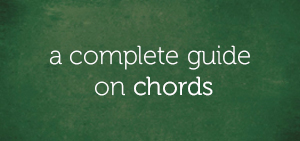When I first got started, major 9th chords seemed so intimidating.
But as I got the fundamentals down pat, I soon recognized that 9th chords, 11th chords, 13th chords, and even altered chords were just as easy to grasp as their little siblings – the triads.
After reading this post, I can guarantee you a few things:
You’ll know exactly what major 9th chords are (and all the other extended chords for that matter), why they’re called that, and where to use them.
But first things first…
Major 9th Chords – Fundamentals
Whenever you see numbers in music, there’s a scale nearby.
(If you don’t know your major scales, click here.)
For example, C major:
You simply number this scale:
C is 1
D is 2
E is 3
F is 4
G is 5
A is 6
B is 7
…and that’s where you get the numbers from.
For example, a “C major” triad:
…turns into a “C major 7” by simply adding the 7th degree of the scale:
B = 7th degree.
There are some other formulas that I cover in my Complete Guide to Chords (free) so be sure to check it out.
Major 9th Chords – Defined
So, to get major 9th chords, 11th chords, and even 13th chords, can you guess what we do?
Yup, we just take our major scale that previously ended on the 8th tone (C) and keep going to the next octave.
(*Octave = The distance of 12 notes. It’s what you get when a note repeats itself higher. For example, hit any C, then go to the right and hit the very next C you find. That’s an octave. Should be 12 notes up.)
If we number this 2-octave scale, we get:
C is 1
D is 2
E is 3
F is 4
G is 5
A is 6
B is 7
C is 8 (octave)
D is 9
E is 10
F is 11
G is 12
A is 13
B is 14
So if we created a “C major 7” chord by taking a triad and adding the “7th” tone (or degree):
C major triad:
C major 7th:
…how do you think we create a “C major 9th” chord?
Yup, we take the major 7th and simply add the 9th tone:
Ladies and gentlemen, the C major 9th chord!
By default, whenever you say “9th” or “11th” or “13th,” it’s supposed to automatically include lesser degrees.
That means, 9th chords already include 7th tones (without having to stipulate it).
11th chords include the 9th and 7th tones.
13th chords include the 11th, 9th, and 7th tones.
In real life, it’s not always this clear though. A lot of times, chords sound better by just “including” certain extended tones like 9ths, 11ths, and 13ths — but not all at once.
So, if you want to be absolutely clear, say “add 9” or “add 11” or “add 13.”
For example, this is a textbook C major 9th chord:
But this is a C major add 9 chord:
This should be seen as a regular C major triad (C E G) with an added “9th” tone. We literally skipped the 7th degree by calling this a regular C major chord with an added 9th.
Get it?
C major 9 = includes everything.
C major add 9 = is a regular C major chord but with an added 9th tone.
But also realize that someone may call a chord a C dominant 13 (you’ll learn this in my free chord guide) but not have all lesser degrees in the chord. It’s common for a 13th chord to be missing the 11th but still be referenced as a 13th. Realize that there is “slang” in music just like in real language. Understand the rules but know that in the real world, there might be another way to do it. :-)
Major 9th Chords – Infographic
And lastly, here’s a handy little chart we created for you to make learning all your major 9th chords a breeze. Enjoy it.

Click to enlarge in a new window
Major 9th Chords – Where to use them?
Major 9th chords can be used anywhere regular major chords are used. Usually, they have the effect of making the chord sound more jazzier/contemporary. They can also enhance the fullness of the chord.
But don’t sacrifice the melody of your song just to add major 9th chords to your playing. Use inversions to “hide” the 9th interval inside the chord like this:
This is almost always a winner. You get the “added” 9th tone (D) for color, but keep the original melody note (G) of your chord on top.
Here are other ways to play it:
There you have it. I hope you enjoyed this super short crash course on major 9th chords.
Until next time.







Comments on this entry are closed.